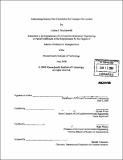Automating journey fare calculation for transport for London
Author(s)
Maciejewski, Joshua J. (Joshua John)
DownloadFull printable version (15.93Mb)
Other Contributors
Massachusetts Institute of Technology. Dept. of Civil and Environmental Engineering.
Advisor
George Kocur.
Terms of use
Metadata
Show full item recordAbstract
This thesis develops a method to automate journey fare calculation for Transport for London. Today, fares for every possible origin-destination station pair within the London Underground are prepared manually based on the zonal fare structure. Multiple feasible paths often exist within the network for a given origin-destination pair, each of which may produce a different journey fare. Thus, manually adjusting journey fares after any alteration of the network or fare structure is a time consuming task for staff and restricts Transport for London's ability to implement changes in fare policy. This approach also lacks transparency from the passenger's perspective. Automating Transport for London's fare calculation requires automating the selection of travel paths. This thesis adapts a label-correcting shortest path algorithm to produce journey paths and fares based on four different selection rules: minimum fare, minimum number of transfers, minimum travel time, and minimum distance. The algorithm operates on a directed graph model of the network. This thesis develops a method to structure the directed graph to capture the network's intricacies. Given a network and fare structure, the modified shortest path algorithm produces all path and fare information for an origin-destination pair in less than one millisecond. Transport for London can then assess the implications of a fare policy change by comparing the existing fares with those generated under each path selection rule. Supplementing these comparisons with historical data provides an estimate of the number of journeys affected and the possible impact on fare revenue. This thesis uses a sample dataset to estimate these impacts.
Description
Thesis (S.M.)--Massachusetts Institute of Technology, Dept. of Civil and Environmental Engineering, 2008. Includes bibliographical references (p. 71).
Date issued
2008Department
Massachusetts Institute of Technology. Department of Civil and Environmental EngineeringPublisher
Massachusetts Institute of Technology
Keywords
Civil and Environmental Engineering.